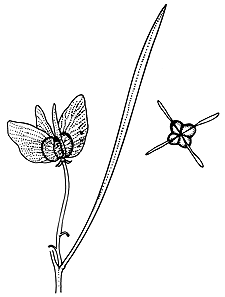Dodonaea stenophylla F.Muell. APNI* 
Description: Erect shrub to 4 m high.
Leaves simple, erect, linear, 3–11 cm long, 1–2.5 mm wide, apex acute, base attenuate, margins revolute, glabrous; sessile or tapering to a petiole 5–7 mm long.
Flowers usually in axillary few-flowered cymes; pedicels 2–15 mm long. Sepals 4, lanceolate or acute, 1.2–1.5 mm long, not persistent. Stamens 8. Ovary glabrous or rarely pubescent near apex.
Capsule 4-, rarely 3-winged, 5–11 mm long, 11–15 mm wide, glabrous; wings 3.5–8 mm wide, membranous.
Distribution and occurrence: in shrubby woodland generally on sandy loamy soils, rare in this State, Bingara district.
NSW subdivisions: NWS
Other Australian states: Qld N.T.
Threatened species: NSW BCA: Vulnerable
The listing of D. stenophylla under the NSW Biodiversity Conservation Act 2016 has changed on 12 Feb 2021 from Presumed Extinct to Vulnerable, following its rediscovery in NSW in 1994 and recent survey work of NSW populations. Dodonaea stenophylla is common in Queensland and parts of the NT and is not considered likely to be nationally threatened. More information can be found in the NSW Threatened Species Scientific Committee Final Determination. Note added by K.L. Gibbons, 12 Feb. 2021.
Text by P. G. Wilson & J. A. Scott
Taxon concept: Flora of NSW 2 (1991)
APNI* Provides a link to the Australian Plant Name Index (hosted by the Australian National Botanic Gardens) for comprehensive bibliographic data
***The AVH map option provides a detailed interactive Australia wide distribution map drawn from collections held by all major Australian herbaria participating in the Australian Virtual Herbarium project.
|


